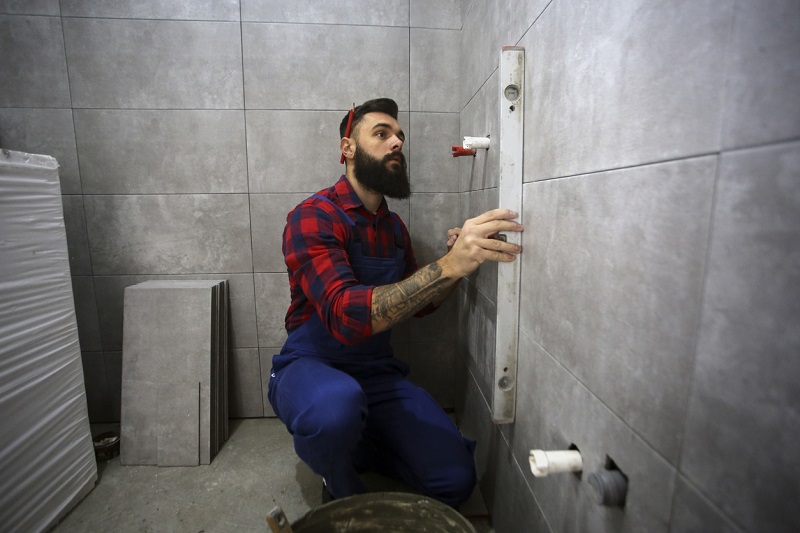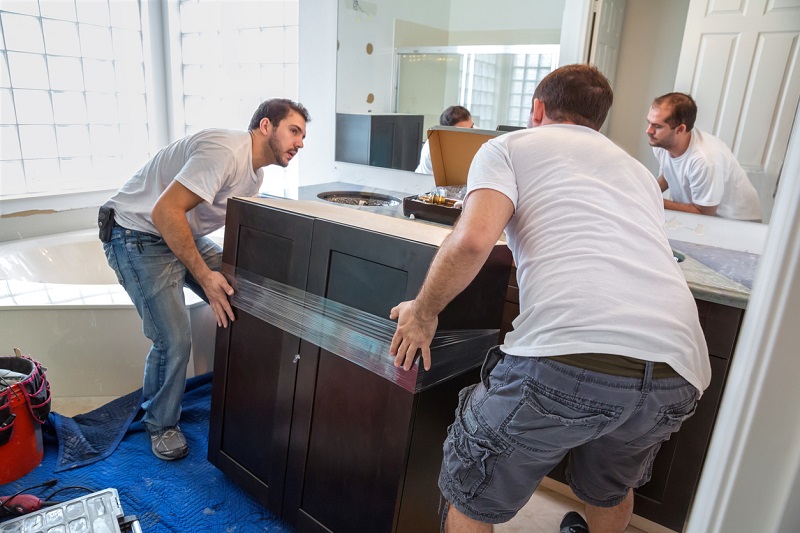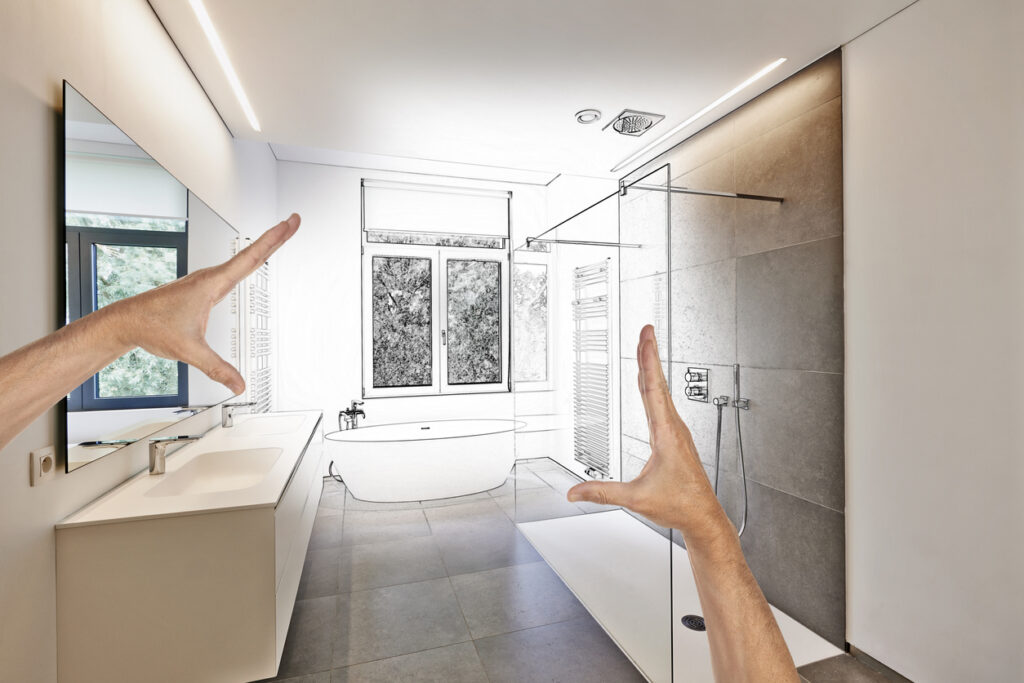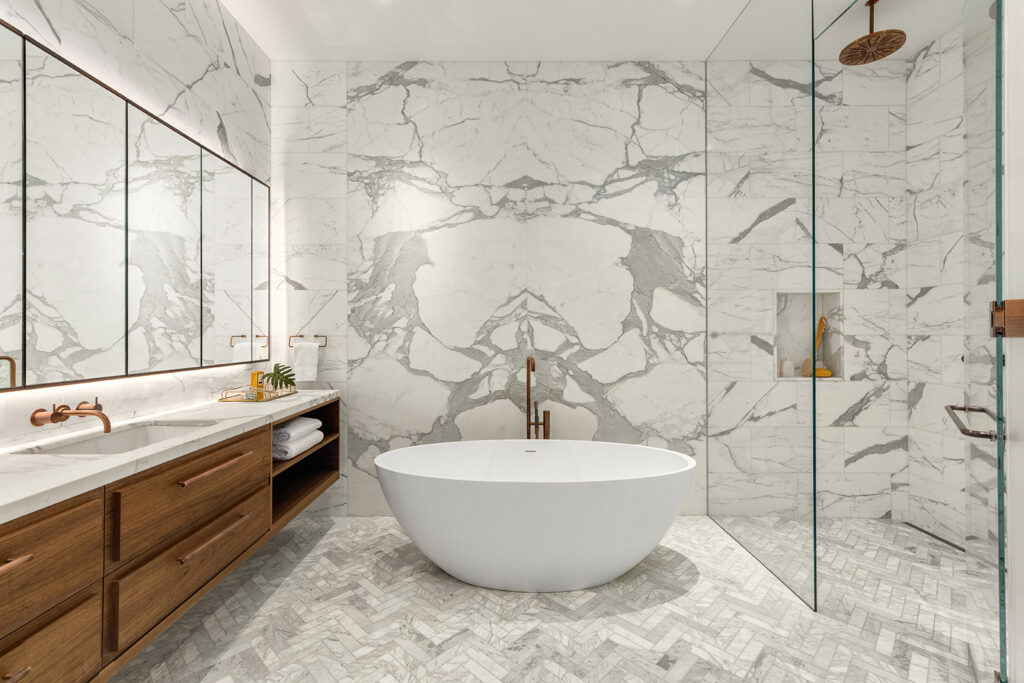
One-Piece vs Two Piece Toilet – Pros and Cons- 2025 Expert Guide
When upgrading your bathroom, one of the most important—and often overlooked—decisions is choosing between a one-piece or two-piece toilet. While
So how much does remodeling a small bathroom cost? The short answer is around $7,000-20,000 in 2024. The long answer is that your bathroom’s materials, labor, and location can drastically increase your price, especially in the year 2024 with significant material shortages. Today we will take a deep look at the cost of this project to help you better understand how a seemingly small remodel can grow to be quite expensive.
There are many costs that go into remodeling a bathroom. Here are the general costs of each part of this project, both for labor and material.

When remodeling a new bathtub, your old bathtub must be taken out and disposed of. This process involves cutting out the existing bathtub. Afterward, the area must be sanded down and cleaned to ensure proper bonding with a new bathtub. Labor costs include removing the old bathtub, disconnecting it from the plumbing before cleaning out the area, removing any drywall or particleboard. Afterward, your new bathtub is installed with the plumbing sorted out and the bathtub is sealed with new sealant or epoxy.
Countertop remodels involve removing your old countertop and disposing of the material in a designated landfill or dump. Removal cost is included with most contractor jobs. After your countertop is taken out and disposed of, your new countertop is placed and installed in your bathroom. Any fixtures such as the sink are then installed with the new countertop and any associated plumbing is sorted out to ensure that it does not conflict with your current configuration.
Bathroom flooring requires that the existing flooring be stripped out and disposed of. To do this, all existing fixtures such as bathtubs, counters, and toilets must first be removed before flooring can begin. Afterward, the contractor will lay out the tile and apply several layers of bonding agent with the material to ensure maximum cohesion with the rest of the floor. The flooring then has to dry for a total of 24 hours before your fixtures are placed back in.
Lighting remodels require an electrician or someone with a solid understanding of electrical systems. This remodel requires that your existing lighting setup be removed and disconnected from the electrical line and put a new setup in its place. Generally, the lighting setup can be placed without damaging your walls, but in rare cases, the existing system may need to be replaced if the wiring is old or not up to code.
A shower remodel is quite similar to a bathtub remodel. First, the area needs to be cleaned out and any existing shower or bathtub needs to be removed from the space. Labor costs involve both removing and cleaning the existing space and pre-sighting it for the new shower. Afterward, the shower space needs to be retiled for both the wall and flooring to ensure proper cohesion and protect the shower from any water damage.
Sink remodels involve removing the existing sink and installing a new countertop or vanity to mesh with the new model. This process involves cutting out and disposing of the old sink before installing a new one in its place. Afterward, plumbing is sorted out to ensure that no part of it will interfere with the countertop or sink.
Wall remodels usually involve stripping or removing the existing tile or paper and inspecting the existing wall’s health and quality. In most instances, the drywall will be replaced, and the tile will be placed over it to ensure the largest amount of exposure and bonding time. Labor costs include removing and replacing any existing tile and ensuring the integrity of the drywall itself. Depending on how large the bathroom is, this can grow to be quite expensive as you are looking at around $800-1700 per wall.
Decor remodels involve numerous outside elements such as furnishings. These furnishings can either be cheap and simple or expensive. Labor for bathroom decor remodels usually involves hiring a professional to create a theme based on the budget you have. This job has a variable cost with affordable jobs landing around $800-1,000 to more expensive jobs costing around $2,000-3,500 with more expansive and complicated themes and styles.
In addition to the primary costs of bathroom remodeling, here are some additional costs to consider:

The location of your bathroom can add additional costs to your install. If your bathroom is located on the second floor of a house, for example, this can create more issues during install. Your contractors may need to carry heavy equipment up and down several flights of stairs or they can’t work on a wall because it’s a load-bearing wall. Typically, the more inconvenient the location is to the rest of your house, labor costs and installation costs can greatly increase.
Materials will ultimately determine the final price of your bathroom. Regardless of labor and installation costs, you should always plan extra room in your budget for materials. If you want higher-quality materials for your bathroom, be prepared to pay for it. For comparison, a acrylic or fiberglass bathtub will generally run around $350-600, whereas a stone resin bathtub will easily run around 1200-2200 depending on the quality.
A new bathroom will always be cheaper to work on compared to an existing bathroom. An existing bathroom creates issues for contractors as they have to rip out and remove all the existing elements of the old bathroom before they can get started. This can increase the cost of your project or even stall it out if the right permits aren’t obtained as different cities have different utility codes that all contractors have to follow.
Hiring an expert is always a recommended idea when starting a new project. Experts have a great deal of experience in home improvement and can provide valuable insight and knowledge that will save you a great headache down the road. Consulting a professional isn’t cheap, however, and they will charge you for their experience and advice. The rate can usually be negotiated, but it is something to keep in mind when hiring a reputable contractor.
The timing of your project can greatly impact the general availability of workers and materials. Summer is often the worst time to start a project as most people choose this time frame to start a project, thus increasing the demand of materials. Spring is generally considered a good time to start a project because winter could have an adverse effect on your workers and the material quality due to changes in weather.

Below are some common smaller bathroom remodel projects and their associated costs.
A stone bathroom floor involves replacing the existing flooring with stone tile. This process involves using a hammer gun and chiseling out the old tile. Once that is done, you will need to clean and remove any of the existing tile from the floor. Afterward, you apply a thin set and level out the bathroom floor, then slowly lay tile, one at a time. Once the tiles are complete, allow thin set to dry before applying sealer and grout. This project can cost anywhere from $300-700, depending on the size of the bathroom.

Painting a bathroom wall involves purchasing paint and a primer coating. The bathroom wall should be cleaned first before applying any paint to ensure maximum adhesion to the wall. Apply primer before painting to ensure that your paint layer will stick to the wall for a longer duration. Between material costs, this project will generally run around $70-400.
Installing a sliding glass shower door requires installing the rails first. You will need to measure out the space accurately, then drill holes on the wall. Hold the stationary glass panels together before attaching them to the panel on the side rail. Afterwards, install the door sweep on the bottom and lock it in place. This project will run you anywhere from $500-1,000 depending on the size and quality of the door.
Installing or adding new sink faucets involve spacing out an appropriate area and installing the sink faucet. So long as it has a line to the plumbing, a sink faucet can easily be installed anywhere you like. This project will generally run $60-120 depending on the quality of the faucet itself.

Installing new storage and cabinets is a simple affair as it simply requires securing new storage units to your bathroom. These generally don’t conflict with current vanity setups and can easily be done DIY. Installing new storage space will generally run anywhere between $300-700 depending on the material used.
Rerouting the plumbing involves tearing open the flooring and wall to access the pipes beyond. This is done to accommodate a bathtub in a new location or to reorganize the current setup in your existing bathroom. Keep in mind that the more complicated the task, the more expensive this becomes. If you want to re-do just the plumbing in your bathroom, a professional will typically charge you anywhere from $600-3,000 depending on the complication of the project itself.
Rerouting the electrical systems involves tearing open the wall and redistributing the electrical lines in your bathroom. This may be required if you want to place an outlet somewhere else or move something incase of an electrical hazard. Before you attempt to DIY this step, please consult a professional first as electrical systems are quite dangerous. This project will run anywhere from $600-1,000.
Resurfacing your bathtub requires a specialized kit. First, you clean your existing bathtub and smooth out any rough edges it may have with an orbital sander. Then, with the bathtub clean and smoothed out, you can apply the resurfacing kit. This involves placing a primer first before applying the epoxy layer. After the epoxy layer has been applied, you can recaulk your bathtub. This project will generally run anywhere from $300-500.
Regrouting your bathroom involves reapplying grout to your bathroom which can be a lengthy affair. First, you want to use a grout saw and carefully remove all your existing grout from the floor. Afterward, you want to carefully and methodically reapply your new grout solution to the same tile, being careful to apply it only on the joints of the tile. Due to the time of this project, you are easily looking at a cost of $300-1200.
The cost of painting your bathroom will vary depending on several different factors. On average, the cost is around $250, with $150 on the low end and anywhere from $300-400 on the high end. Here are the typical costs associated with this project:
A gallon of paint will cost between $20-100 per gallon, with glossier paints adding $2 per gallon for each additional gloss level.
A painter will charge anywhere from $1-4 per square foot or $20-50 per hour. This is the bulk of the cost when painting your bathroom. If you can DIY the project, you can cut the price in half, saving you money. For a DIY job, these are the supplies you are looking for and the prices associated:

Moisture and high humidity can cause mold if your bathroom is not properly ventilated. Consider installing more fans and windows to increase air circulation in your bathroom and prevent mold damage down the line.
Leaks in the plumbing can be disastrous if left ignored, so routinely inspect your plumbing and fixtures so you can deal with the problem as soon as possible.
You will need to waterproof the walls around the shower or bath, so choose a material that can handle high humidity, or you may pay for it in the long run.
Depending on the layout of your bathroom, you may need to order custom cabinets to accommodate unusually shaped walls or height changes. Remember that custom-made items take longer to build and will be much more expensive than retail items.
Outdated electrical systems are power inefficient and can cause deadly power spikes. Depending on your existing layout, you will need to update your electrical systems before remodeling, requiring an electrician to upgrade your wiring. Depending on the complexity, this can be quite costly, so inspect your electrical system before starting.
The best way to save some money is to do some of the things on your own, whether it’s painting or demolition. However, if you’re not skilled enough, choosing to do it on your own might actually cost you more money that hiring a professional straight away.
If you’re determined to do a part of the remodeling project on your own, the best thing you can do is to divide the project into two phases. First one will cover everything that you feel capable of doing and the second one will involve the work of a professional. Most contractors will not have a problem with splitting the work with homeowners, but make sure you discuss these with them first to avoid misunderstandings.
If you plan to do some of the remodeling at the same time, make sure you do it while the contractor is not around to ensure you’re not distracting them from the work you’re paying them to do.
Below are some examples of small bathrooms to get an understanding of how much space is available.

A half bath is a bathroom that contains just a toilet and sink, but rarely has a shower or bathtub. A half bathroom is the smallest bathroom size available and generally sits around 15-18 square feet, or the size of a small closet.

A three-quarter bathroom is a bathroom that contains either a shower or bathtub along with a sink and a toilet. In general, the minimum space for a three-quarter bathroom is at least 36 square feet.
Below are some of the sizes you are likely to encounter when looking at small bathrooms.

Remodeling in stages allows you to focus better on one area rather than the entire bathroom at once. When remodeling, the highest cost will come from changing foundations, removing walls, changing plumbing lines, relocating fixtures such as toilets or tubs, and finally, electrical wiring. Staging out your remodel will provide a better plan and allow you to reduce labor costs by hiring professionals for tasks that aren’t easy to DIY.
Your tub, toilet and shower are expensive and awkward fixtures to move through your bathroom. Moving these items will require professionals and may require the removal of walls and altering plumbing lines and electrical systems. By planning your remodel around these existing fixtures, you can save a great deal of money and hassle.
Purchasing materials yourself can greatly reduce your final price. Contractors won’t typically shop around, so you will always pay market rate for your materials. In addition, you can’t verify the quality of the material yourself until after purchase. By shopping around, you can always ensure you get the best deal and ensure high quality before it is installed.
For example, you can use laminate flooring to simulate either natural stone or wood, depending on your preference. Ceramics and porcelain can even mimic the look of travertine and marble.
If the option is available, refinish a fixture rather than replace it. A bathtub refinish can breathe new life and update it’s look and cost anywhere from $50-100. On the other hand, a new bathtub install can cost anywhere from $4,000-10,000 depending on the size and location, so consider refinishing your fixtures if you want to update their look.
Opt out of hiring a bathroom designer and do it yourself. Bathrooms are small rooms without any complications, so they provide an excellent starting place for beginners. Spend time studying existing layouts and take inspiration online to get started.
Many aspects of a remodel can be done by yourself without hiring a professional. This will not only save a large bit of money but can accelerate the completion time of your remodel. These aspects include painting, small plumbing jobs, installing your vanity and countertops, installing your toilet, and floor replacements, to name a few. Of course, it is highly advised that you should only do DIY jobs that you are skilled in. Plumbing and electrical jobs are best left to professionals, so use your best judgment before you begin.
There are certain mistakes that we’ve noticed many homeowners make when they begin to remodel their bathroom. To help you avoid them, we’ve gathered them all in the list below:
Remodeling any bathroom can be an expensive and exhausting affair. So do your research, be confident in what you want, and plan accordingly to avoid overspending on this project. If you need a piece of advice from an expert, reach out to us and we’ll help you to remodel your bathroom by sharing our extensive knowledge and experience!

Eric is the founder and president of Badeloft USA. He has been the president of Badeloft’s US division for over ten years and oversees all marketing and branding aspects of Badeloftusa.com.
His expertise lies in small business development, sales, and home and bathroom industry trends and information.
Contact us with any business related inquiries.

Free material samples and tub templates

When upgrading your bathroom, one of the most important—and often overlooked—decisions is choosing between a one-piece or two-piece toilet. While

Small details, including what you place on the floor, can make a big difference when setting up or upgrading your

Plumbing traps may seem like small components, but they are critical in keeping your home safe and odor-free. Two of
When shopping for new bath linens, the difference between a bath towel and a bath sheet can feel subtle, but
Fill out the form below to request a free material sample
"*" indicates required fields
"*" indicates required fields
"*" indicates required fields